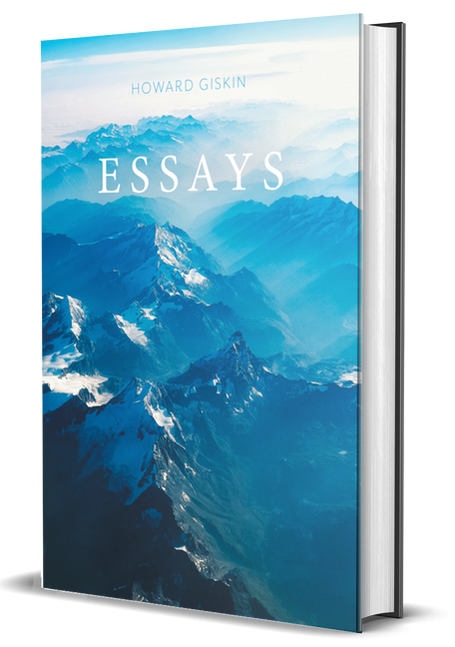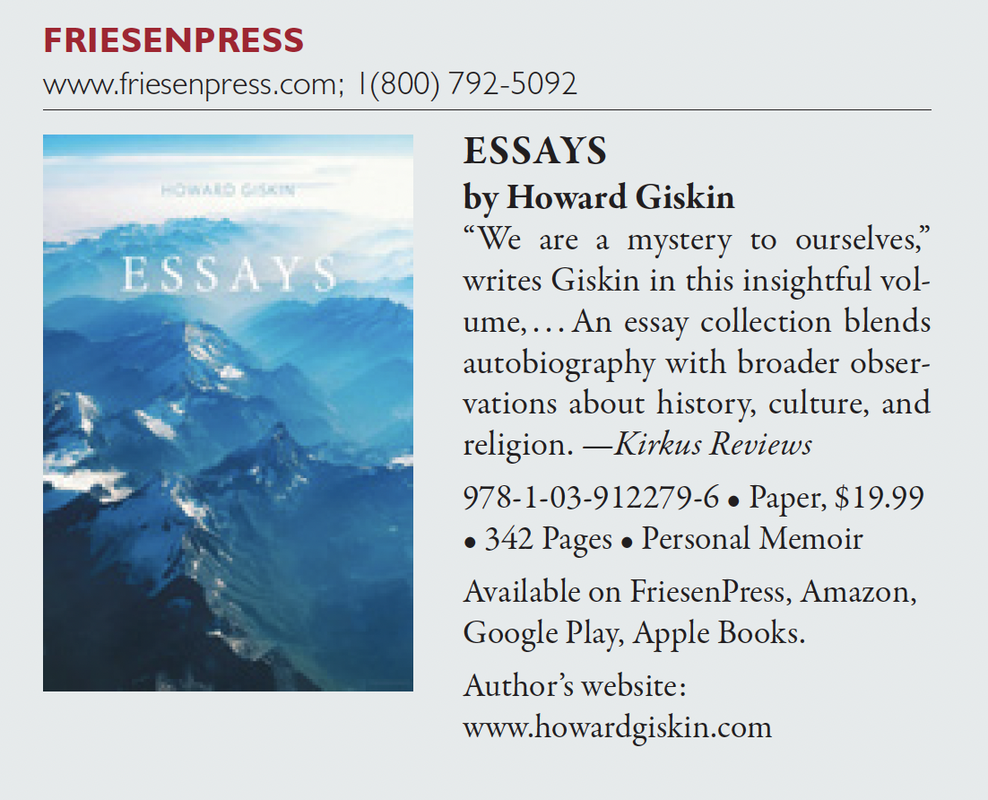About the BookThese essays are an exercise in self-examination, a meditation on the author’s life and interests as they have evolved over time. Part memoir and part reflection on the broad range of human concerns, Essays explores memories of the author’s early years and family life, as well as some of the extensive international traveling he has done throughout the years since. Other essays delve into his experiences of solitude, art and literature, astronomy, evolution, the nature of time, consciousness, museums, world history, and the Holocaust.
This wide-ranging collection of essays preserves and presents Howard Giskin’s experiences and the lessons he’s learned. Thought-provoking and contemplative, Essays encourages deeper thinking in an age of quick-fix entertainment. |
Reviews
"An essay collection blends autobiography with broader observations about history, culture, and religion.
“We are a mystery to ourselves,” writes Giskin in this insightful volume, “so writing about oneself and one’s interests is both a revelatory act as well as a process of discovery.” The first two-thirds of the book’s 44 essays are autobiographical in nature, as the author offers vignettes from his childhood and observations about his own family, travels, and inner life. Growing up in New York City in the early 1960s as his father completed a doctorate from Columbia University, Giskin delivers personal essays that effectively balance nostalgia and wit with poignant retrospective analyses on such topics as playgrounds, drive-in movies, and Halloween. An avid world traveler, the author offers readers nearly a dozen essays that use trips to Japan, Greece, Africa, and elsewhere as lenses through which to explore metaphysical concepts related to life, death, love, and humanity. The collection’s final third moves away from Giskin’s personal experiences and perspectives toward a broader commentary on culture, science, history, and philosophy. As a retired educator, the author has a solid grasp of art across genres and time periods, classical and modern philosophy and literature, and world religions. Essays in this section provide scholarly commentary, for instance, on the visual arts and include high-quality, color reproductions of various works. One piece provides an in-depth exploration of the poetry of Walt Whitman. Other essays analyze the poetry and art of World War I and critique Arnold Toynbee’s A Study of History. Though an agnostic, Giskin, whose previous books on Chinese culture have been published by academic presses, is clearly influenced by Eastern spirituality and thought. A predilection toward concepts like Zen Buddhism, combined with the author’s American upbringing and deep knowledge of the Western canon of high culture, provides a unique, erudite perspective that thoughtful readers will appreciate. Alternately, Giskin’s “exercise of getting on paper things swarming about in my head” is at times disjointed, focusing on topics that are perhaps better suited for a separate collection.
An astute and informed, if eclectic, assemblage of essays."
- Kirkus Reviews
“We are a mystery to ourselves,” writes Giskin in this insightful volume, “so writing about oneself and one’s interests is both a revelatory act as well as a process of discovery.” The first two-thirds of the book’s 44 essays are autobiographical in nature, as the author offers vignettes from his childhood and observations about his own family, travels, and inner life. Growing up in New York City in the early 1960s as his father completed a doctorate from Columbia University, Giskin delivers personal essays that effectively balance nostalgia and wit with poignant retrospective analyses on such topics as playgrounds, drive-in movies, and Halloween. An avid world traveler, the author offers readers nearly a dozen essays that use trips to Japan, Greece, Africa, and elsewhere as lenses through which to explore metaphysical concepts related to life, death, love, and humanity. The collection’s final third moves away from Giskin’s personal experiences and perspectives toward a broader commentary on culture, science, history, and philosophy. As a retired educator, the author has a solid grasp of art across genres and time periods, classical and modern philosophy and literature, and world religions. Essays in this section provide scholarly commentary, for instance, on the visual arts and include high-quality, color reproductions of various works. One piece provides an in-depth exploration of the poetry of Walt Whitman. Other essays analyze the poetry and art of World War I and critique Arnold Toynbee’s A Study of History. Though an agnostic, Giskin, whose previous books on Chinese culture have been published by academic presses, is clearly influenced by Eastern spirituality and thought. A predilection toward concepts like Zen Buddhism, combined with the author’s American upbringing and deep knowledge of the Western canon of high culture, provides a unique, erudite perspective that thoughtful readers will appreciate. Alternately, Giskin’s “exercise of getting on paper things swarming about in my head” is at times disjointed, focusing on topics that are perhaps better suited for a separate collection.
An astute and informed, if eclectic, assemblage of essays."
- Kirkus Reviews
"Focusing on a passion for travel and nature, Howard Giskin’s Essays is a philosophical memoir.
Wide-ranging and often disconnected, the book’s sections highlight topics including pivotal travel memories, personal experiences and relationships, art and museum visits, and lifelong musings. Their imagery is evocative: one mentions a “balmy lilac-scented night” spent sipping wine on an open-air porch in Greece.
References to personal growth following Peace Corps adversity during an assignment in Africa recur as Giskin confronts physical and mental challenges while climbing in the High Sierra. Lessons learned while hiking gain force as the book progresses. Giskin details climbing to the summit of a 12,000-foot peak, which leads into an interesting discussion of the art of self-reliance. Looking over a 60-foot precipice results in heightened awareness and a description of the fragility of life. Giskin discusses the danger of a single misstep with acute sensitivity while also expressing his deepening appreciation of traveling with wisdom. Elsewhere, Giskin’s experiences in nature are covered in terms of how encounters with it enhanced his life. He expresses appreciation for trees, as well as covering his disorienting struggle to emerge from a forest, which is said to mirror his ongoing quest for understanding.
But the entries covering Giskin’s relationships and everyday experiences are more meandering. They include discussions of road trips with a friend, memories from the playground, tales of drive-in movies, and nods to a golf course near his childhood home. They are punctuated by longing for the “boundless energy of youth.” Their lessons are familiar ones, as on the importance of common sense and clear communication. In “Mother,” Giskin questions how well people can ever know their parents, wondering about the dreams that are sacrificed when one starts a family.
Working to tame the swarm of thoughts that it represents, the book raises provocative questions throughout its disparate essays. They include inquiries into why people are drawn to unknown places, or why they remember some experiences and forget others. The suggestion that one’s memory shapes their perceptions of life is made as a partial answer.
Simple graphics of mountain peaks mark the beginning of the essays, and small leaf images are used to signal some section breaks. Images of paintings by Wassily Kandinsky, Piet Mondrian, and Joan Miró embellish a section that analyzes their artwork; these are helpful additions, used to raise points about how art can be said to reflect the horror and beauty of each age. Sections on melancholy and world weariness conclude the winding text, whose essays are interspersed with poems that deviate from its prose descriptions of travel and relationships.
The autobiographical collection Essays covers both aging and hope in its forward-looking trajectory."
- Foreword Clarion Review
Wide-ranging and often disconnected, the book’s sections highlight topics including pivotal travel memories, personal experiences and relationships, art and museum visits, and lifelong musings. Their imagery is evocative: one mentions a “balmy lilac-scented night” spent sipping wine on an open-air porch in Greece.
References to personal growth following Peace Corps adversity during an assignment in Africa recur as Giskin confronts physical and mental challenges while climbing in the High Sierra. Lessons learned while hiking gain force as the book progresses. Giskin details climbing to the summit of a 12,000-foot peak, which leads into an interesting discussion of the art of self-reliance. Looking over a 60-foot precipice results in heightened awareness and a description of the fragility of life. Giskin discusses the danger of a single misstep with acute sensitivity while also expressing his deepening appreciation of traveling with wisdom. Elsewhere, Giskin’s experiences in nature are covered in terms of how encounters with it enhanced his life. He expresses appreciation for trees, as well as covering his disorienting struggle to emerge from a forest, which is said to mirror his ongoing quest for understanding.
But the entries covering Giskin’s relationships and everyday experiences are more meandering. They include discussions of road trips with a friend, memories from the playground, tales of drive-in movies, and nods to a golf course near his childhood home. They are punctuated by longing for the “boundless energy of youth.” Their lessons are familiar ones, as on the importance of common sense and clear communication. In “Mother,” Giskin questions how well people can ever know their parents, wondering about the dreams that are sacrificed when one starts a family.
Working to tame the swarm of thoughts that it represents, the book raises provocative questions throughout its disparate essays. They include inquiries into why people are drawn to unknown places, or why they remember some experiences and forget others. The suggestion that one’s memory shapes their perceptions of life is made as a partial answer.
Simple graphics of mountain peaks mark the beginning of the essays, and small leaf images are used to signal some section breaks. Images of paintings by Wassily Kandinsky, Piet Mondrian, and Joan Miró embellish a section that analyzes their artwork; these are helpful additions, used to raise points about how art can be said to reflect the horror and beauty of each age. Sections on melancholy and world weariness conclude the winding text, whose essays are interspersed with poems that deviate from its prose descriptions of travel and relationships.
The autobiographical collection Essays covers both aging and hope in its forward-looking trajectory."
- Foreword Clarion Review


